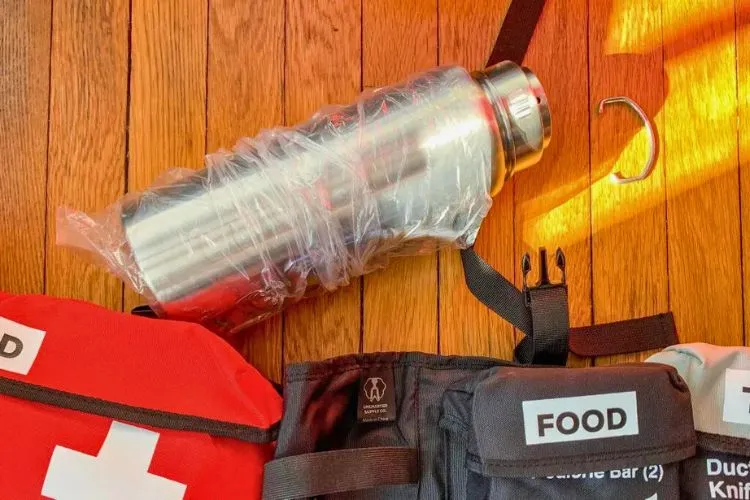In a world where uncertainty lurks around every corner, preparation is key. A well-equipped ‘Bug Out Bag’ could be the difference between survival and otherwise in a critical situation.
This tool, often overlooked, is a lifeline when disaster strikes. But the question remains, what to put into a bug out bag? Be it a natural disaster or a sudden upheaval, the contents of this bag directly affects your survival.

In this article, we will guide you through the essential items required to build an optimal bug out bag, ensuring you remain safe, healthy, and prepared for any potential emergencies.
What to put into a bug out bag?
Crafting the best bug out bag requires thorough planning and an understanding of your needs during an emergency.
While personal preferences may vary, there are some essentials that should always make their way into your bug out bag. We’ve compiled the must-have items you need to ensure you’ll be safe, healthy, and prepared for any potential emergencies.
Communication and Navigation Gear

- Cell Phone and Portable Charger: In emergency situations, communication and access to necessary information are crucial. Don’t forget your cell phone, charged and with useful numbers and apps. Additionally, a high-capacity portable charger ensures your phone maintains power.
- Radio: A battery-operated or hand crank radio with NOAA (National Oceanic and Atmospheric Administration) channels will provide essential updates, news or alerts.
- Maps and Compass: Knowing your surroundings is vital, especially if electronic devices fail. Local maps and a compass keep you well-informed about your location and help you find safe areas efficiently.
Shelter and Clothing
- Emergency Tent or Tarp: Look for lightweight, easy-to-pack options like tube tents or tarps with grommets. These will provide basic shelter and protection from harsh weather conditions during an emergency.
- Sleeping Bag and Blankets: Insulated, space-saving sleeping bags are essential for warmth and comfort, especially in cold climates. Compressed blankets take up very little space and can serve as extra sleeping pads or warmth.
- Waterproof and Changing Clothing: Pack a change of clothes and sturdy, waterproof shoes or boots suitable for walking on various terrains. Opt for moisture-wicking materials or layers, gloves, and hats for weather protection.
Food and Water

- Water: Water is a top priority in any situation. Pack a minimum of a 72-hour supply of purified, bottled water. Collapsible water containers are ideal, as they take up less space when not in use.
- Portable Water Filters: Emergency water filters, such as LifeStraw or Sawyer Mini, can be lifesaving when your water supply runs out, making water from various sources safe to drink.
- Non-Perishable Food: Pack non-perishable, easy-to-prepare food items with minimal packaging, like energy bars, MREs (Meals Ready to Eat) or freeze-dried meals. Prioritize high-calorie foods needing little to no cooking.
First Aid and Hygiene Supplies
- Basic First Aid Kit: A well-stocked first aid kit containing bandages, gauze, adhesive tape, scissors, pain relievers, antiseptic wipes, tweezers, and other essentials is indispensable for managing injuries or minor illnesses.
- Prescription Medications: Ensure you have an adequate supply of any necessary prescription medications, as well as a copy of your prescriptions to facilitate refills or replacements.
- Personal Hygiene Items: Include travel-sized toiletries such as toothbrushes, toothpaste, soap, sanitary pads, toilet paper, and similar items to maintain hygiene during your emergency scenario.
Lighting and Heat Sources

- Flashlight: A waterproof flashlight with extra batteries or a solar-powered or hand-crank model is essential for navigating in the dark and signaling for help.
- Headlamp: A headlamp is an added bonus, providing hands-free lighting while performing tasks or moving in dark environments.
- Emergency Fire Starter: Waterproof matches, lighters, or a magnesium fire starter help to start fires quickly in any weather, providing heat and light for cooking and comfort.
Tools and Multitask Equipment
- Multi-tool or Knife: A quality multi-tool or knife is indispensable for performing various tasks, from cutting ropes to opening cans.
- Paracord or Rope: Paracords provide numerous uses, including constructing shelters, tying things up, and signaling for help.
- Whistle: A loud, rescue whistle can signal for help from a distance, alerting nearby rescuers or other survivors.
Personal Documents and Cash

- Photocopies of Documents: Keep photocopies of vital documents, such as IDs, insurance information, and emergency contacts, in a waterproof envelope or container.
- Cash and Coins: Having a small amount of cash and coins on hand will come in handy if access to financial institutions or ATMs is restricted during an emergency.
Carefully curating the contents of your bug out bag is crucial to ensure your safety, health, and preparedness. Customize your bag according to individual needs and regularly review and update your supplies to stay ready for any potential emergencies.
Bug Out Bag Checklist for Families
When disaster strikes, it’s not just about you. Having your family prepared is critical. Here’s a comprehensive Bug Out Bag checklist designed for families, ensuring everyone’s needs are taken into consideration.

For Each Family Member
- Personal Documents and Cash:
- Copies of identification documents in a waterproof container for each family member (i.e., ID cards, birth certificates, passports)
- An emergency contact list
- Small denominations of cash and coins
- Clothing:
- Spare set of clothes suitable for the season (T-shirt, pants, underwear, socks)
- Rain poncho
- Hat (sun hat for summer, warm hat for winter)
- Gloves
- Food and Water:
- 72-hours worth of water
- High-energy, non-perishable food items suited to each person’s needs and dietary restrictions
- Portable water filter or purification tablets
- Miscellaneous:
- Prescription medicines and medical supplies if required
- Photos or other comfort items, especially for children
- Whistle, to signal for help
Shared Family Items
- Shelter and Bedding:
- Light-weight tent/tarp
- Sleeping bags/pads for each family member
- Emergency blankets
- First Aid Supplies:
- Comprehensive first aid kit suitable for the group size
- Extra Personal Protective Equipment (PPE) items such as masks, gloves, etc.
- Communication and Navigation:
- Hand-crank or battery-power radio
- Map of local area
- Compass / GPS
- Mobile phone with a list of emergency contacts
- Tools
- Multi-tool or Swiss Army knife
- Paracord or sturdy rope
- Duct tape
- Illumination and Fire:
- Fire starters (matches/lighters/fire starters)
- Headlamps or flashlights (plus spare batteries)
- Lantern or other area lighting
- Hygiene Supplies:
- Toilet paper or baby wipes
- Hand sanitizer
- Personal hygiene supplies like toothbrush and toothpaste, feminine hygiene products
- Child Specific Needs:
- Diapers and baby wipes for infants
- Change of clothes
- Formula if required
- Pet Care, if applicable:
- Leash, collar, and ID tag
- Dog clothing if necessary
- Pet food and bowl
- Poop bags and/or cat litter
Remember, it’s essential to adjust the contents of your bug out bag based on the specific needs of your family members and pets.
Routinely update the list to ensure that it remains accurate and up-to-date. The key is to start preparations now, so when an emergency strikes, you’re ready to keep your loved ones safe and secure.
frequently asked question (FAQs)
What food is good in a bug out bag?
Answer: High-energy, non-perishable, easy-to-eat foods are ideal for a bug out bag. This includes items such as energy bars, trail mix, dried fruits, canned tuna or chicken, peanut butter, and crackers. Meals Ready-to-Eat (MREs) and freeze-dried camping foods are also good options as they are lightweight and easy to prepare. Consider packing a lightweight camping stove or a compact cooking tool for heating water and cooking meals. Make sure the food caters to dietary restrictions if any.
How much cash should you have in a bug out bag?
Answer: The amount of cash you should carry in a bug out bag can vary depending on your situation, but a good rule of thumb is to carry around $200 – $300. This should be a mix of small denominations and coins as you never know what expenses you might encounter in an emergency situation. Cash can especially be useful when electronic transactions may not be possible due to power outages or network issues. Remember to keep the cash safe and dry in a waterproof container or envelope.
How do you pack water in a bug out bag?
Answer: When packing water in your bug out bag, consider using bottled water or hydration bladders as they are easy to carry. Aim for at least a three-day supply of water, which equates to around 9 liters per person. Always prioritize having a method of purification available like a LifeStraw, portable water purification tablets, or a collapsible water bottle with a built-in filter. Hydration powder packs or water purifying tablets can also be a valuable addition to save space and weight in your bag.
Conclusion:
A well-prepared bug out bag is your lifeline during emergencies, providing essential sustenance, shelter, and support for survival. It should be tailored to meet your individual or family needs, the local environment, and potential emergency situations.
Carefully selecting and packing non-perishable food, water, clothing, medical supplies, and practical tools can significantly enhance your comfort, safety, and chances of survival.
Regular reviewing and updating of your bug out bag contents ensure its effectiveness when required. It’s one small but crucial step towards preparedness and resilience in the face of uncertainty.


